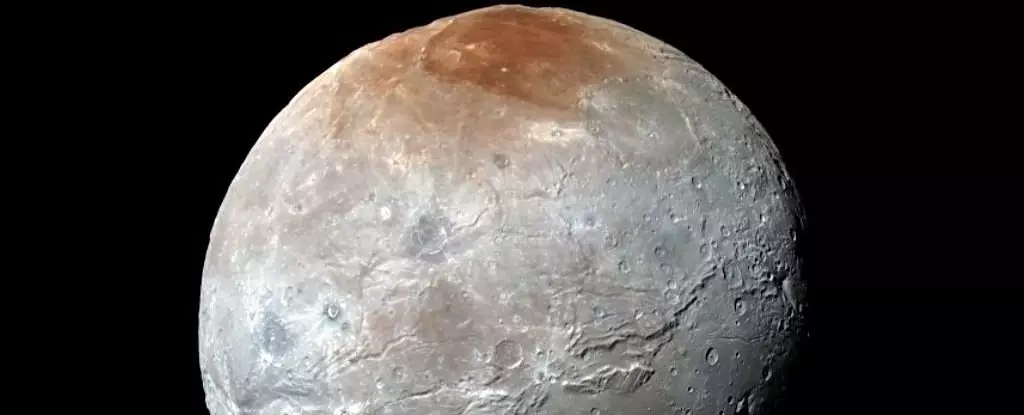Pluto, once classified as the ninth planet, now holds the title of a dwarf planet and resides a staggering 5.7 billion kilometers from the Sun. Within this distant realm lies Charon, Pluto’s largest moon, which has intrigued scientists since its discovery in 1978. Charon, at approximately 1,200 kilometers across, is a curious celestial body that exists in a unique gravitational dance with Pluto. Both objects share a binary orbit around a point in space, distinguishing them from traditional planet-moon pairings, like Earth and its Moon. This unusual relationship raises questions about their formation and the mechanisms that govern their respective surfaces.
Recent research spearheaded by astronomer Silvia Protopapa and her team, published in *Nature Communications*, has provided fresh insights into Charon’s composition. Analysis from the James Webb Space Telescope has revealed the presence of carbon dioxide and hydrogen peroxide on Charon’s surface, marking a significant advancement in our understanding of this frigid moon. This discovery not only highlights the importance of Webb in astronomical explorations but also provides a window into the geological and chemical processes that may have shaped both Charon and Pluto itself.
Unlike Pluto, which is primarily composed of nitrogen and methane ices, Charon’s surface exhibits a complex mix of chemical compounds. While initially characterized as a cold, icy body, Charon’s surface dynamics tell a tale of geological activity. Past data gathered by NASA’s New Horizons mission has demonstrated Charon’s rich composition, featuring water ice, ammonia, and various carbon-based materials. Intriguingly, the presence of cryovolcanoes—a phenomenon resembling volcanic activity but involving icy eruptions—has been suggested, broadening our understanding of its geological history.
The Implications of Carbon Dioxide and Hydrogen Peroxide
The identification of carbon dioxide and hydrogen peroxide on Charon opens the door to a deeper comprehension of its formation and ongoing processes. Carbon dioxide, a fundamental molecule in planetary science, serves as a historical marker, unveiling clues about the moon’s evolving landscape. The prevailing theory posits that the carbon dioxide observed may originate from Charon’s subsurface, trickling up due to impacts from celestial objects that create craters, thereby exposing fresh materials. This geological activity may signify a richer and more active history than previously understood.
Technological Advancements and Spectroscopy Techniques
The success of this discovery owes much to the technological advancements embodied in the James Webb Space Telescope. Launched in 2021, this state-of-the-art observatory is equipped with a six-and-a-half meter diameter mirror, enabling it to detect infrared light—an essential spectrum unattainable to the human eye. Utilizing a technique known as spectroscopy, Webb can break down the light emitted from Charon into its constituent wavelengths, revealing distinct signatures that correspond to various elements and compounds. This approach not only enhances our understanding of Charon but also applies broadly to other celestial bodies throughout our Solar System.
One of the most captivating aspects of Charon is its origin story, a topic ripe for scholarly debate. A leading hypothesis suggests that Charon was born from a colossal impact event, much like the formation of Earth’s Moon. Over 4.5 billion years ago, a sizable object from the Kuiper Belt might have collided with Pluto, ejecting debris that eventually coalesced into Charon. Alternatively, the two bodies could have been distinct entities that collided and subsequently became gravitationally bound to each other. Understanding Charon’s complex composition and the newly detected compounds can provide pivotal insights into both possibilities, enriching our broader understanding of planetary formation in the outer Solar System.
The recent findings on Charon serve not only as a revelation about this distant moon but also as a significant contribution to our comprehension of the trans-Neptunian region at large. As scientists continue to explore the intricate relationships and compositions of bodies like Pluto and Charon, they unlock secrets of the Solar System’s distant past. The ongoing quest for knowledge in our cosmic neighborhood sheds light on the processes that shape these ice-covered worlds, revealing that there is much more to learn in the vastness of space. As research progresses, we may soon uncover further mysteries hiding beneath the icy surface of Charon and its dwarf planet companion.

